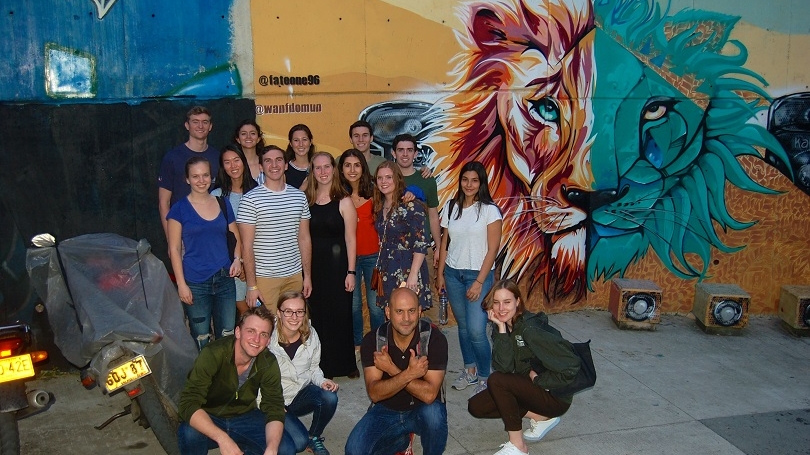
- Public Policy
- Leadership
- Funding
- News & Events
- About the Center
Back to Top Nav
Back to Top Nav
Back to Top Nav
Back to Top Nav
Our second day in Medellin began at a local university, EAFIT, for a meeting on criminality and the state with Professor Gustavo Duncan. Professor Duncan gave us a brief lecture on the the peace deal and delved into the complicated history of governance in Medellin and the rural parts of the country. An expert in the relationship between criminality and the state, he detailed the complicated ties between neighborhoods, citizens, businesses, and gangs. Professor Duncan shed light on Colombians different relationship to justice—one where citizens often rely criminal actors to distribute justice in place of the government.
After our meeting with Professor Duncan, we retired back to the hotel for food and did some much needed laundry. Then it was back on the bus, which drove us into the heart of Medellin. The rest of our day would be spent exploring the sprawling Medellin cityscape. We met our guide, Santiago Uribe, at a metro stop in the bustling market called San Antonio but commonly known as “el Hueco” (the shaft). As trams and metro cars bustled overhead, vendors lining the streets hawked speakers, machinery, and plátano. Uribe guided us onto the metro and we headed from el Hueco towards the cable lines.
Medellin is built unlike any city I have ever been to. Nestled into a valley, Medellin has had to adapt as its population exploded from 20,000 to 2 million in under a hundred years. The city has climbed its way up the sides of the valley, creating complicated networks of steep streets that divide the city center from its hilly outskirts. In recent years, Medellin has constructed a complex transportation network of trams, metros, and cable cars to lift people up, down, and around the city.
Our first destination with Uribe was up the cable cars to a neighborhood known as Santo Domingo. There, we navigated the steep streets as we learned about how public transportation had opened new opportunities for residents. We headed to a “House of Justice”, a building where local judges helped resolve neighborhood disputes—a new alternative to violence.
After San Domingo, we hustled back onto the metro and towards a neighborhood known as Sección 13, an area wracked by gang violence in the past that has since become an attraction to bold tourists such as ourselves. The neighborhood is home to what we figured was the only escalator-based public transportation system. The escalators ferried us quickly up the neighborhood and spit us out onto an avenue covered in graffiti. We walked along the street and took in graffiti to our left and a panoramic view of the Medellin sprawl to our right.
We headed out from Sección 13 around sunset, taking time to patronize a few local stores in return for our safe trip. Upon returning to our home base, Poblado, we headed out to a nice dinner celebrating the birthday of Emily (happy 22nd!) before heading back to the hotel for some much needed rest. Much more is in store tomorrow—stay tuned. Hasta Mañana!
Written by Max Kanefield '19, 18F PBPL 85: Global Policy Leadership course participant
This is part of a series where PBPL 85:Global Policy Leadership students reflect on their experiences during the two-week field research portion of course. While in country, students meet with local policy leaders: politicians, academics, civil society leaders, journalists, business leaders, diplomats, and other in-country experts who help inform their analyses.